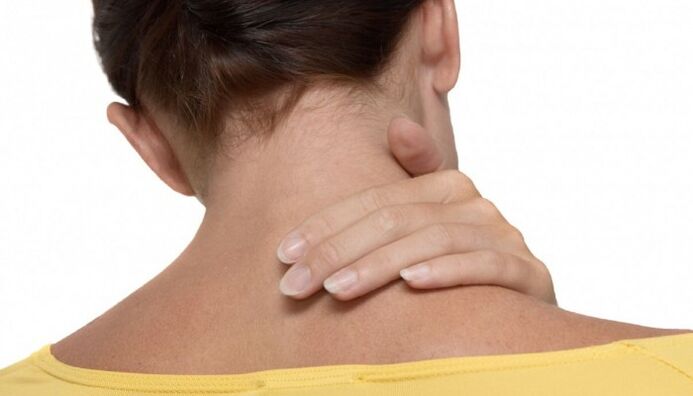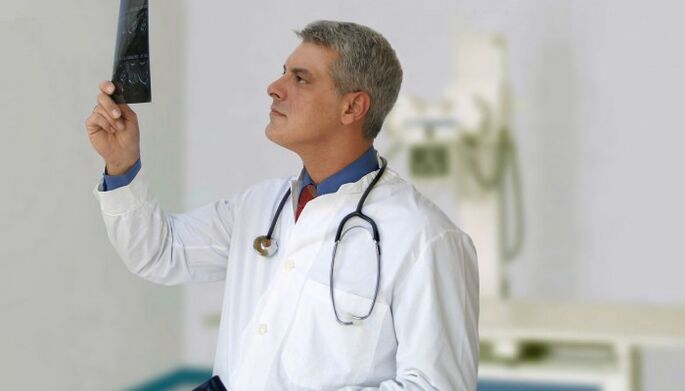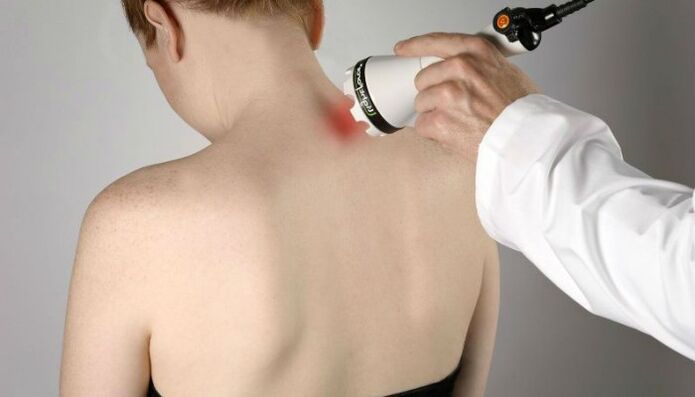Various back or side neck pains can occur suddenly and always cause significant discomfort. Particular vigilance should be evoked by constant painful feelings of an intense nature. Neck pain and upper back pain may also be associated with other clinical symptoms such as difficulty in the back of the head, fatigue, fatigue, headache, restricted movement.
If the pain syndrome persists for more than a week and the treatment started does not produce the desired results, professional medical help should be sought. Don’t distract yourself from the opportunity to get rid of a painful illness quickly and effectively.
The reasons

Quite a few people wonder why their necks hurt? As practical experience shows, there can be several reasons for this. Clarification of such issues should only be handled by a specialist, as the correctness of treatment depends directly on this. The most common causes of back and side pains in the neck can be very severe and frequent:
- Pathology of the cervical spine (various injuries, bruises, displacements, intervertebral hernias, osteochondrosis, spondyloarthrosis and so on).
- Myogelosis of the neck.
- Great physical activity.
- Being in an uncomfortable position for a long time (such as sleeping in a sitting position).
- Cervical sciatica.
- Muscle tension (sudden head movement, improper exercise).
It has been found that even banal scoliosis can cause pain.
Pathology of the cervical spine
If the patient complains that the neck and upper back hurts quite severely and frequently, pathology of the cervical spine should be ruled out first and foremost.
Particular attention should be paid to osteochondrosis and spondylosis. Today, it is the two most common diseases of the spine, in addition to injuries and injuries that can cause very significant pain and discomfort in the neck and upper shoulder girdle. Characteristics of pain syndrome in degenerative-dystrophic pathology of the cervical spine:
- Pain is perceived at rest, even if the patient tries not to move at all.
- It is usually quite difficult for them to choose a situation in which they do not feel pronounced painful feelings.
- Restrictions on cervical spine mobility are almost always noted.
- Mild pressure on the cervical vertebrae can cause increased pain.
Cervical spine myogelosis

A pathological condition in which painful compression of muscle fibers involves a violation of local blood circulation is called myogelosis. The provocative factors are usually:
- Hypothermia and frostbite.
- Cover is blowing.
- Prolonged uncomfortable situation.
- Physical fatigue (excessive stress).
Most experts believe that myogelosis should be considered a complication after the inflammatory process in the muscles. It should be noted that this is not only manifested by pain, but also by problems with muscle relaxation, increased tone, and limited mobility. In addition, the pain often extends to the upper back and shoulder girdle. If myogelosis is left untreated, there is a risk that it will worsen your health, as the disease is prone to progression and chronic course.
If you do not know the real cause of your neck, it is better to see a doctor immediately.
Cervical sciatica

Pinching of the nerve roots exiting the spinal cord at the level of the cervical spine leads to sciatica. According to clinical practice, in the vast majority of cases, osteochondrosis causes the development of this pathology. In sciatica, patients notice that the neck hurts and burns, making it simply impossible to touch from the back or side. What is the clinical picture of cervical nerve root damage from the spinal cord:
- The neck, shoulder blades and shoulder girdle are severely and constantly sore.
- Painful feelings are usually exacerbated by movements of the head, arms, and upper body.
- The neck muscles are too tense.
- Violation of hand sensitivity (numbness, tingling, etc. ).
- Weakness in the upper limbs.
- Dizziness.
- Headache.
- Increased fatigue.
Spasm

Despite the severity of the pain syndrome, muscle tension is considered one of the mildest pathologies and can be cured fairly quickly compared to other diseases that cause pain in the neck and upper back. Injuries, poor exercise, and increased stress can lead to muscle tension. What complaints will patients express at the same time:
- Sharp pains in the neck, back of the head and upper shoulder girdle.
- Excessive muscle tension that limits the mobility of the head and cervical spine.
- The general condition suffers (physical discomfort, weakness, fatigue appear).
- Her neck hurts when she turns her head.
Diagnostics

Without knowing the specific cause of pain in the cervical region, it is quite difficult to completely eliminate this pathological symptom. If we eliminate only the painful feelings and not what causes them, we can only expect a temporary improvement in the condition. Modern diagnostic methods allow you to quickly narrow down the range of possible causes that cause back pain on your back, side, or both sides. As a general rule, the following instrumental tests are used:
- Normal X-ray examination.
- Ultrasonic examination.
- Electrocardiography.
- Electromyography.
- Magnetic resonance imaging.
Treatment
What to do if your neck hurts? Even at home, there are some remedy steps you can take to reduce your pain. If pain is associated with injury or muscle strain, a cold compress is recommended for the first 48 hours.
A very effective remedy is to apply ice or cold objects to the neck area for about 15 minutes, every few hours. Direct contact with the skin should be ruled out to avoid the formation of cold burns causing contact with ice. To do this, ice or very cold objects are placed in a plastic bag, supplemented with a not-too-thick cloth, and only then applied to the skin surface.
After two days, they switch to a warm compress. You can use a standard plastic hot water bottle or rubber heating pad. The duration of the compress should not exceed 20-30 minutes. This procedure can be repeated every 2 hours. Also, give proper rest to your sore muscles. After an injury or sprain, go to bed more often first, try to relax your neck muscles. It is best to relieve tension by lying on your back. In the acute stage, it will be helpful to limit yourself to a variety of physical activities. Take a short break from exercise.
Keep in mind that a very long rest helps to weaken the muscles of the neck and shoulder girdle. Once you return to your normal rhythm, it will be easy to gain new, already weakened muscles. The alternation of dosed physical activity and good rest is considered optimal, but only in the absence of severe pain. Traditional pain relief is as follows:
- Drug therapy.
- Local treatment.
- Physiotherapy procedures.
- Manual therapy.
- Massage
- Physiotherapy.
Talk to your doctor about what to do if your neck hurts.
Drug therapy

Painkillers help to quickly relieve neck pain of varying intensity. Today, many of these drugs can be purchased at pharmacies without a prescription. However, it should be recalled that most of these drugs have a significant number of side effects and contraindications. Therefore, any medication should be discussed with a specialist. Non-steroidal anti-inflammatory drugs are most commonly used as analgesics.
Numerous clinical studies have shown that taking NSAIDs can cause a number of side effects. Most problems are associated with erosive and ulcerative lesions of the gastrointestinal tract. In addition, quite often, along with pain syndrome, there is marked tension in the neck muscles. It is recommended to use muscle relaxants to relieve muscle cramps.
Local therapy

Topical therapy has been shown to be useful in the treatment of neck and upper back pain. Usually all kinds of medicinal ointments, gels and creams are used which have a pronounced analgesic effect. Certain types of drugs are very popular as external agents.
The mechanism of action of the analgesic is different and depends on the active ingredient in the ointment, gel or cream. Only a qualified doctor can tell you which medicine is best for you. With intense pain, causing significant discomfort, novocaine blockade is sometimes prescribed. Medical compresses have also been shown to be effective. The average duration of the procedure is about 30 minutes. A total of at least 7-8 procedures must be performed to achieve the desired result.
If you’re not quite sure what to do if your neck and upper back hurt, it’s best to consult a professional first.
Physiotherapy

In most cases, physiotherapy treatment is actively involved, consisting of various procedures, massage sessions, and physiotherapy practices. Many years of experience have shown the effectiveness of the following physiotherapy methods to relieve pain:
- Electrophoresis.
- Ultrasound therapy.
- Electrotherapy.
- Magnet.
- Laser.
- Acupuncture.
Exercise therapy and massage
Therapeutic practices and massage are a mandatory element of complex therapy for almost any disease or condition. However, many forget that they can only be used once the acute stage is over. Severe pain syndrome is considered a contraindication during exercise and massage. Example of a basic set of physical exercises to relax and strengthen the neck muscles:
- You can stand or sit. The most important thing is to keep your back straight. The hands should be loose and lowered. Make 10 head decisions, first on one side and then on the other. Do the exercise at a leisurely pace without sudden movements.
- The situation is similar. We lower our heads and try to touch the front surface of our chest with our chin. The number of repetitions is ten times.
- The situation is similar. Imitating a duck, we perform the head movements back and forth. The number of repetitions in both directions is ten times.
- Slow circular movement of the head. If painful feelings occur, we stop the exercise.
- We sit in a chair. Place your palm on your forehead. We tilt our heads forward as we try to resist with our palms. Exercise helps strengthen the front neck muscles. You can also place your palms to the left, right, and back, and tilt your head to the right side.
- Stand up straight. Loosen your arms and place them along your body. We tilt our head to one side first while lifting our shoulders and then to the other. The number of repetitions is 10-12 times.
After briefly informing the physiotherapist or other specialist, therapeutic exercises and self-massage of the collar zone can be performed regularly and at home without any problems.
ethnoscience

It’s hard to argue with the fact that traditional medicine has long been firmly grounded in our lives. However, if you are not sure what the particular folk remedy is, it is not recommended to use it during treatment. Many physicians have repeatedly experienced serious consequences in their clinical practice due to the misuse of non-traditional therapies. In some cases, it is permissible to use certain folk remedies to relieve pain, but only after consulting a doctor. For the sake of familiarity only, we present a number of recipes for traditional medicine:
- You can apply regular fresh cabbage leaves to the painful area. There are no time limits. Compressions made from cabbage leaves also have a good effect.
- Rubbing honey. The massaging honey is rubbed into the area of the neck where the patient is experiencing the greatest pain.
- Mustard salt compaction. Cooking requires one kilogram of table salt, a spoonful of mustard powder and 100 ml of water. Pour all the ingredients into the pan and heat for 5 minutes. The mixture is then poured into a tissue bag that is placed on the sore neck area. You can wrap warm clothes around your neck (such as a scarf) to enhance the effect.
Prophylaxis

In many cases, the appearance of rather unpleasant pain in the neck can be prevented. To do this, various injuries, muscle strain and heavy physical exertion should be avoided. Freezing or supercooling is highly undesirable. Active sports are also recommended, but not to the detriment of your health. Do not start chronic diseases, especially degenerative-dystrophic diseases of the musculoskeletal system. Have a comprehensive medical examination at least once a year.
































